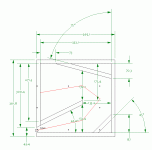Have you considered going active, it would make the speaker design much simpler and more easily controlled?
Yes, I have dabbled with active in the past. But I wanted to give passive a go. I recently purchased a new amp, Cambridge Audio CXA60 which has a built in dac a remote control and a pre-out. The remote control gives a certain higher WAF factor. The pre-out means I could use it as a pre-amp with active xovers or even a combination of the two, making use of the power amp part with a high level passive filter and a low level filter feeding into another amp. Lots of dabbling to do.😀
Last edited:
Have you considered going active, it would make the speaker design much simpler and more easily controlled?
The other advantage I'm looking for (actually the main advantage I'm hoping for) is a reduction of reflections through the cone which is advantageous regardless of xover type.
Statements
The Statements use a straight square tube. They mention in their design the goal of reduced resonance etc. They are using 2nd order LR filters at 350Hz and a notch filter to deal with driver resonance.
As I mentioned earlier, a spiral sealed and tapered TL works very well to absorb back reflections, smooths the impedance curve, while behaving like an open baffle.
An Objective Comparison of 3in - 4in Class Full Range Drivers
TL vs OB in frequency:
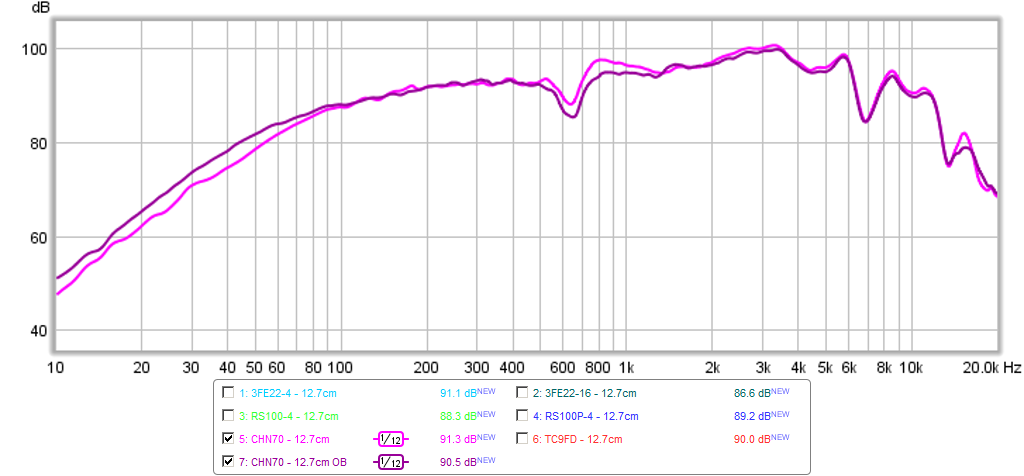
TL vs OB in impedance:
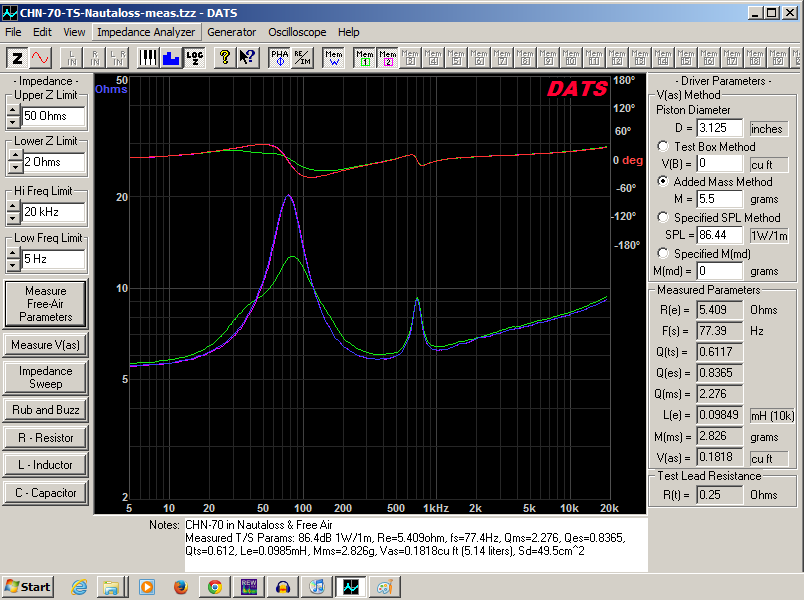
The strange looking FR is because of native response of the driver, a CHN-70.
Same measurements of frequency response with other drivers in same TL give nicer result:
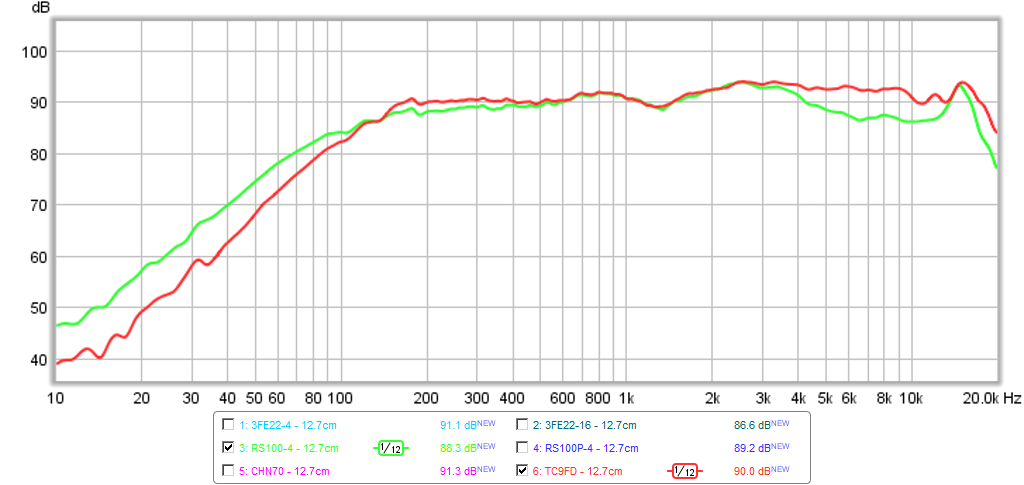
Photo of TL and trapezoidal baffle:
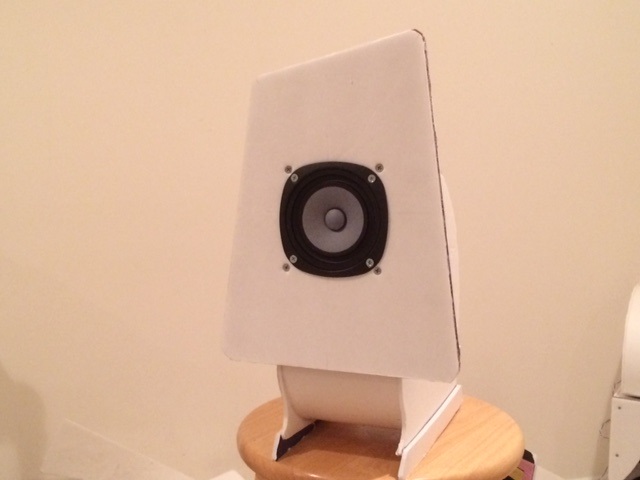
Internals of the Nautaloss TL:
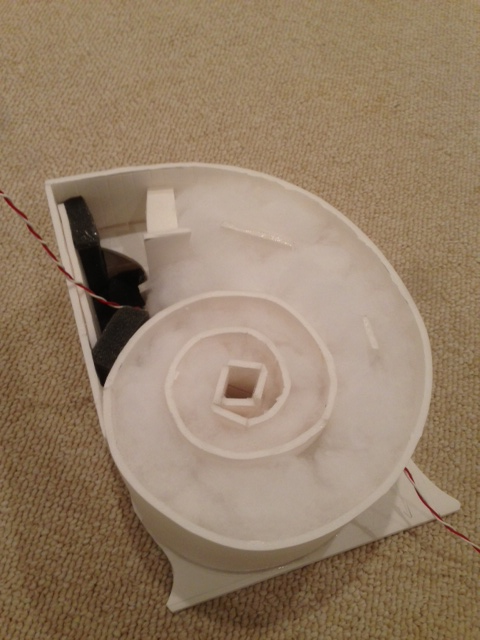
The Nautaloss Ref Monitor
An Objective Comparison of 3in - 4in Class Full Range Drivers
TL vs OB in frequency:

TL vs OB in impedance:

The strange looking FR is because of native response of the driver, a CHN-70.
Same measurements of frequency response with other drivers in same TL give nicer result:

Photo of TL and trapezoidal baffle:

Internals of the Nautaloss TL:
The Nautaloss Ref Monitor
Last edited:
Thanks Xrk971, in the link in your previous post I couldn't see the comparison with OB as you have shown here in this post and in this liink. Its interesting that the OB you used is quite large, I was imagining something smaller so didn't understand the significance.
The significance is more that an OB has no back reflections to worry about and the TL does a good job of absorbing the back wave so it doesn’t color the front wave sound. This is shown by fact that the two frequency responses are similar.
I was worried that the roll off would too sudden and steep, i.e. the driver's roll off plus the 6db/oct loss from an open baffle. However since the baffle was quite large in your test then the response should be close to the manufacturers response curve. I'm not worried by the response below 100Hz or so but more concerned about the xover point of about 350Hz down to 100Hz.
I was concerned that the dagger response due to a smaller volume wouldn't be quite as good especially if the driver's Vas was a bit larger, it might not suite the Pluvia 7 but might be ideal for the Alpair 5.2.
I was concerned that the dagger response due to a smaller volume wouldn't be quite as good especially if the driver's Vas was a bit larger, it might not suite the Pluvia 7 but might be ideal for the Alpair 5.2.
Well, Dagger is simply a tapered sealed HW mid-TL (that's not meant as a criticism or critique, just stating the baseline operating physics), and precisely the same remarks as I made above about the open mid-TL apply to it also. Acoustically speaking it's a little under-sized for the unit in question, but should be OK with a bit of extra damping. Its polar response is different to an open baffle since it's a monopole, not a dipole, but as X notes, his reference is in terms of subjective lack of colouration caused by the back-wave. Your actual anechoic response & rolloff characteristic is a combination of the box and baffle load.
Last edited:
Depends on the design specifics; there isn't a fixed answer to that per se. However, assuming volume swamps Vas, or at least is sufficient not to have excess gain peaking at Fp, then tapering a sealed mid-TL is worth the effort inasmuch as you can usually get away with a smaller stuffing density & have fewer issues with lateral eigenmodes. Since the pipe is stuffed anyway, and in most mid-TLs these are likely to be at a releatively high (easily suppressed shorter wavelengths) frequency this particular aspect is rarely a major issue, but for the sake of a little extra effort, might as well do everything you can that helps. This can apply particularly if the internal walls are in relatively close proximity to the driver, which is generally best avoided, but not always feasible.
I am late to the thread, but as an adovcate of midTLs i should add my bit.
Whhat Scott says proves to be pretty spot on. Tapering the line is a benefit. We usually try for a 10:1 taper and integrate the midTL into the box with the bass drivers. A spearate box on top gives more versatility.
The goal is to lose all of the back wave and flatten the impedance (giving independance of amp choice).
Our 1st was in Tysen V1, also used in Tysen V2, Ellppsa (apologies to Sonus Faber), the Facets, and the big A12pw MTM. We have built those, i have drawn many more.
A heavily tapered midTL can be built into a simple rectangular box with a single partition.
This is an early work (midTL for Feastex IIRC). The deflector panels turn out to be unnecessary, and except for the bracing added, add nothing to the box.
Scale th econcpt to the size you need, as long as total volume hits the target Scott suggests.
dave
Attachments
for a mid-TL damping (stuffing or lagging) is extremely important. Some like a progressive damping density (increasing density as you move toward the terminus), others prefer it to be uniform. Technically it doesn't make much difference in & of itself in the majority of such applications; I prefer the former for short pipes of this type simply because it reduces the possibility of the air mass-loading the moving components of the driver and preventing it from oscillating / resonating as designed
+1
Being able to measure the line impedance quickly is useful for tuning the stuffing. The goal is to reduce the resonant peak as much as possible. I did this extensively for a 4” circular xSection midTL i did for A5. It was hard to get as close as we did on Tysen V1 with little effort.
dave
A short conical TL sealed with stuffing progressively dense towards vertex works great as an acoustic black hole.
X’s dagger is a good design for a closed midTL. It should be 2x as long and at least the same volume. It will model as sealed. I prefer the low pressure of a quarter-wave TL so that the back wave affects the front as little as possible.
dave
Bearing in mind that efficiency of the low frequencies are unneeded, they will be filtered off. It's the impedance flattening that is desirable in order to make it easier for a 1st order xover. If I can reduce the Z somewhat and reduce it further with a parallel R across the drive unit that may suffice.
Understood, just pointing out it can take considerable volume to get the necessary stuffing density, you just can't keep packing it in tighter as this can quickly reverse and act like a tiny sealed box with the attendant high Fb, Qtc..
GM
- Home
- Loudspeakers
- Full Range
- A question about mid-tweeter transmission lines.
